KIA Cadenza 2014 1.G Owner's Manual
Manufacturer: KIA, Model Year: 2014, Model line: Cadenza, Model: KIA Cadenza 2014 1.GPages: 415, PDF Size: 5.09 MB
Page 261 of 415
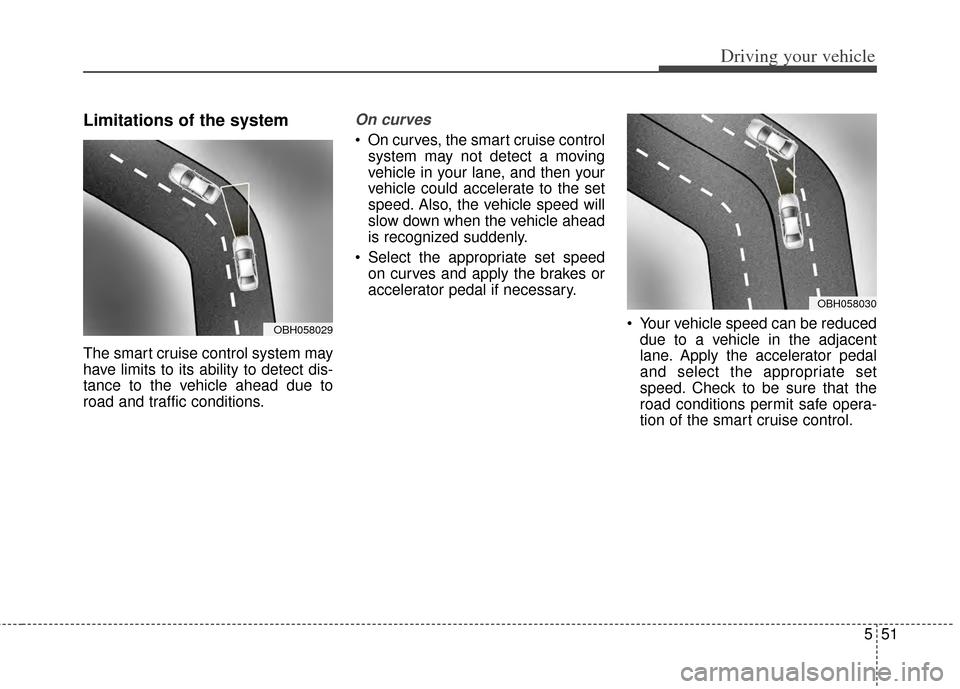
551
Driving your vehicle
Limitations of the system
The smart cruise control system may
have limits to its ability to detect dis-
tance to the vehicle ahead due to
road and traffic conditions.
On curves
On curves, the smart cruise controlsystem may not detect a moving
vehicle in your lane, and then your
vehicle could accelerate to the set
speed. Also, the vehicle speed will
slow down when the vehicle ahead
is recognized suddenly.
Select the appropriate set speed on curves and apply the brakes or
accelerator pedal if necessary.
Your vehicle speed can be reduceddue to a vehicle in the adjacent
lane. Apply the accelerator pedal
and select the appropriate set
speed. Check to be sure that the
road conditions permit safe opera-
tion of the smart cruise control.
OBH058030
OBH058029
Page 262 of 415

Driving your vehicle
52
5
On inclines
During uphill or downhill driving,
the smart cruise control system
may not detect a moving vehicle in
your lane, and cause your vehicle
to accelerate to the set speed.
Also, the vehicle speed will slow
down when the vehicle ahead is
recognized suddenly.
Select the appropriate set speed on inclines and apply the brakes or
accelerator pedal if necessary.
Lane changing
A vehicle which moves into yourlane from an adjacent lane cannot
be recognized by the sensor until it
is in the sensor's detection range.
The sensor may not detect imme- diately when a vehicle cuts in sud-
denly. Always pay attention to the
traffic, road and driving conditions.
If a vehicle which moves into your lane is slower than your vehicle,
your speed may decrease to main-
tain the distance to the vehicle
ahead. If a vehicle which moves into your
lane is faster than your vehicle,
your vehicle will accelerate to the
selected speed.
OBH058045OBH058053
Page 263 of 415

553
Driving your vehicle
Vehicle recognition
Some vehicles ahead in your lane
cannot be recognized by the sensor
as follows:
- Narrow vehicles such as motorcy-cles or bicycles
- Vehicles offset to one side
- Slow-moving vehicles or sudden- decelerating vehicles
- Stopped vehicles
- Vehicles with small rear profile such as trailers with no loads A vehicle ahead cannot be recog-
nized correctly by the sensor if any of
following occurs:
- When the vehicle is pointing
upwards due to overloading in the
trunk
- When operating the steering wheel
- When driving to one side of the lane
- When driving on narrow lanes or on curves
Apply the brakes or accelerator
pedal if necessary.
OBH058046
WARNING
The vehicle cannot be stopped by using the smart
cruise control system.
If an emergency stop is nec-
essary, you must apply the
brakes.
Keep a safe distance accord- ing to road conditions and
vehicle speed. If the vehicle to
vehicle distance is too close
during a high-speed driving, it
may cause a serious collision.
The smart cruise control sys- tem can not recognize a
stopped vehicle, pedestrians
or an oncoming vehicle.
Always look ahead cautiously
to prevent unexpected and
sudden situations from occur-
ring.
(Continued)
Page 264 of 415
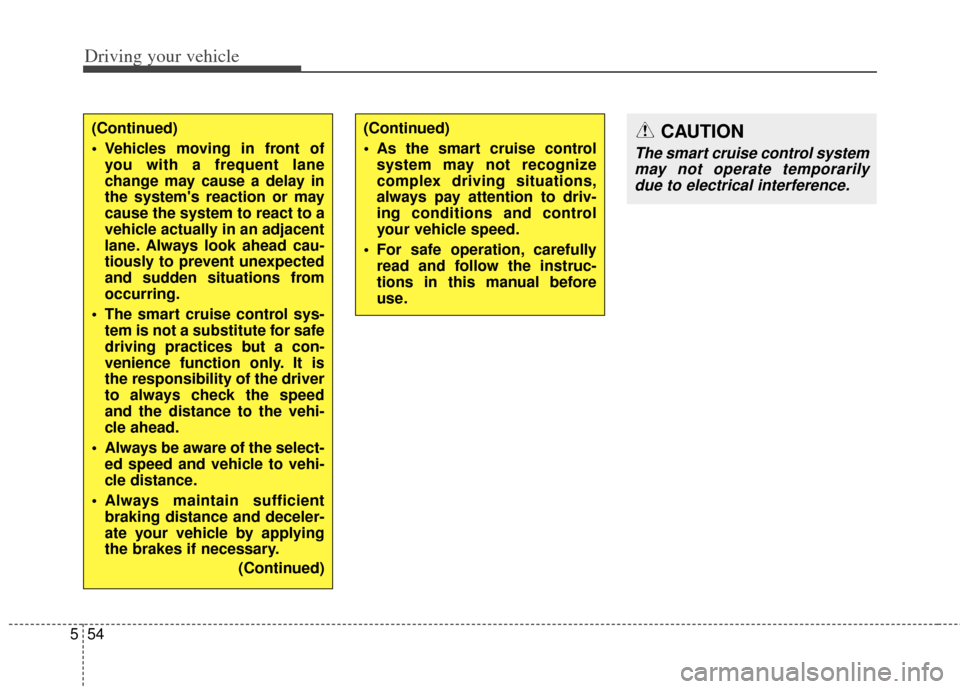
Driving your vehicle
54
5
(Continued)
Vehicles moving in front of
you with a frequent lane
change may cause a delay in
the system's reaction or may
cause the system to react to a
vehicle actually in an adjacent
lane. Always look ahead cau-
tiously to prevent unexpected
and sudden situations from
occurring.
The smart cruise control sys- tem is not a substitute for safe
driving practices but a con-
venience function only. It is
the responsibility of the driver
to always check the speed
and the distance to the vehi-
cle ahead.
Always be aware of the select- ed speed and vehicle to vehi-
cle distance.
Always maintain sufficient braking distance and deceler-
ate your vehicle by applying
the brakes if necessary.
(Continued)(Continued)
As the smart cruise controlsystem may not recognize
complex driving situations,
always pay attention to driv-
ing conditions and control
your vehicle speed.
For safe operation, carefully read and follow the instruc-
tions in this manual before
use.CAUTION
The smart cruise control systemmay not operate temporarilydue to electrical interference.
Page 265 of 415

555
Driving your vehicle
This system detects the lane with the
sensor at the front windshield and
warns you when your vehicle leaves
the lane.
LANE DEPARTURE WARNING SYSTEM (LDWS) (IF EQUIPPED)
OVG059041
OVG053314
WARNING
The LDWS does not make thevehicle change lanes. It is the
driver's responsibility to
always check the road condi-
tions.
Do not turn the steering wheel suddenly, when the LDWS
warns that your vehicle is
leaving the lane.
If the sensor cannot detect the lane or if the vehicle speed
does not exceed 43 mph
(70km/h), the LDWS won't
warn you even though the
vehicle leaves the lane.
If your vehicle has window tint or other types of coating on
the front windshield, the
LDWS may not work properly.
Prevent damage to the LDWS sensor from water or any liq-
uid.
Do not remove the LDWS parts and do not damage the
sensor by a strong impact.
(Continued)
(Continued)
Do not put objects that reflectlight on the dash board.
Always check the road condi- tions for you may not hear the
warning chime because of
audio, or external noise.
Page 266 of 415
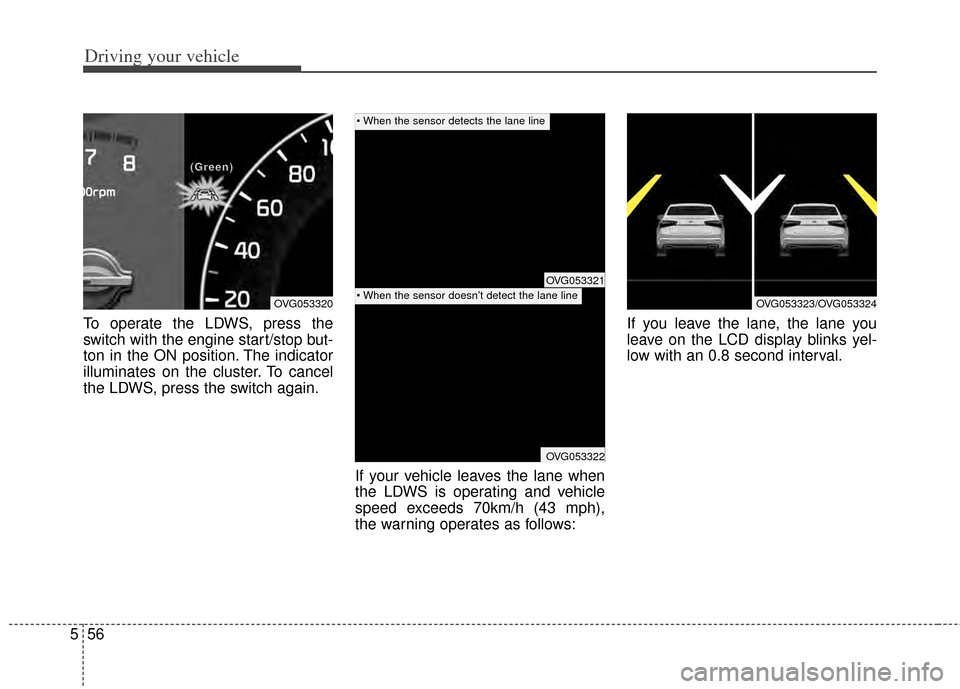
Driving your vehicle
56
5
To operate the LDWS, press the
switch with the engine start/stop but-
ton in the ON position. The indicator
illuminates on the cluster. To cancel
the LDWS, press the switch again.
If your vehicle leaves the lane when
the LDWS is operating and vehicle
speed exceeds 70km/h (43 mph),
the warning operates as follows:If you leave the lane, the lane you
leave on the LCD display blinks yel-
low with an 0.8 second interval.
OVG053320
(
(
(
(
G
G
G
G
r
r
r
r
e
e
e
e
e
e
e
e
n
n
n
n
)
)
)
)
OVG053321
OVG053322
OVG053323/OVG053324
Page 267 of 415
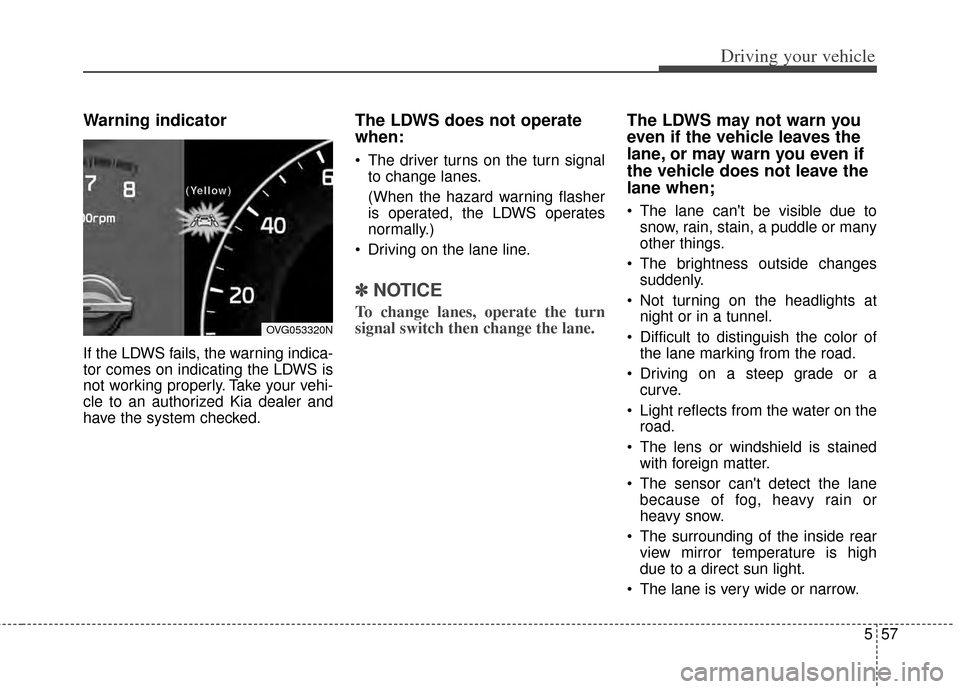
557
Driving your vehicle
Warning indicator
If the LDWS fails, the warning indica-
tor comes on indicating the LDWS is
not working properly. Take your vehi-
cle to an authorized Kia dealer and
have the system checked.
The LDWS does not operate
when:
The driver turns on the turn signalto change lanes.
(When the hazard warning flasher
is operated, the LDWS operates
normally.)
Driving on the lane line.
✽ ✽ NOTICE
To change lanes, operate the turn
signal switch then change the lane.
The LDWS may not warn you
even if the vehicle leaves the
lane, or may warn you even if
the vehicle does not leave the
lane when;
The lane can't be visible due to
snow, rain, stain, a puddle or many
other things.
The brightness outside changes suddenly.
Not turning on the headlights at night or in a tunnel.
Difficult to distinguish the color of the lane marking from the road.
Driving on a steep grade or a curve.
Light reflects from the water on the road.
The lens or windshield is stained with foreign matter.
The sensor can't detect the lane because of fog, heavy rain or
heavy snow.
The surrounding of the inside rear view mirror temperature is high
due to a direct sun light.
The lane is very wide or narrow.
OVG053320N
(
(
(
(
Y
Y
Y
Y
e
e
e
e
l
l
l
l
l
l
l
l
o
o
o
o
w
w
w
w
)
)
)
)
Page 268 of 415
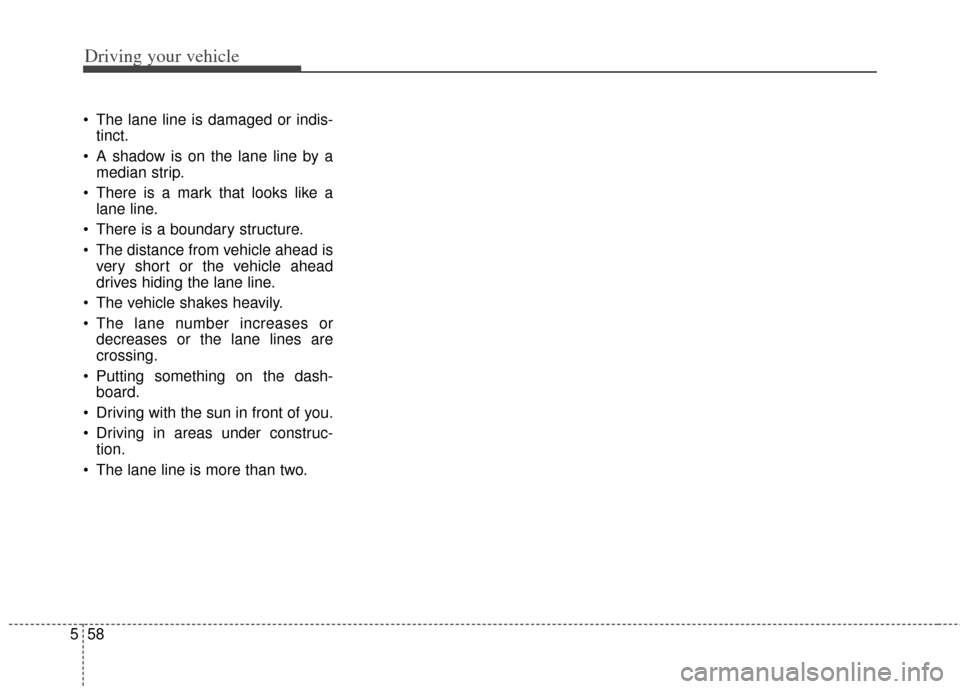
Driving your vehicle
58
5
The lane line is damaged or indis-
tinct.
A shadow is on the lane line by a median strip.
There is a mark that looks like a lane line.
There is a boundary structure.
The distance from vehicle ahead is very short or the vehicle ahead
drives hiding the lane line.
The vehicle shakes heavily.
The lane number increases or decreases or the lane lines are
crossing.
Putting something on the dash- board.
Driving with the sun in front of you.
Driving in areas under construc- tion.
The lane line is more than two.
Page 269 of 415
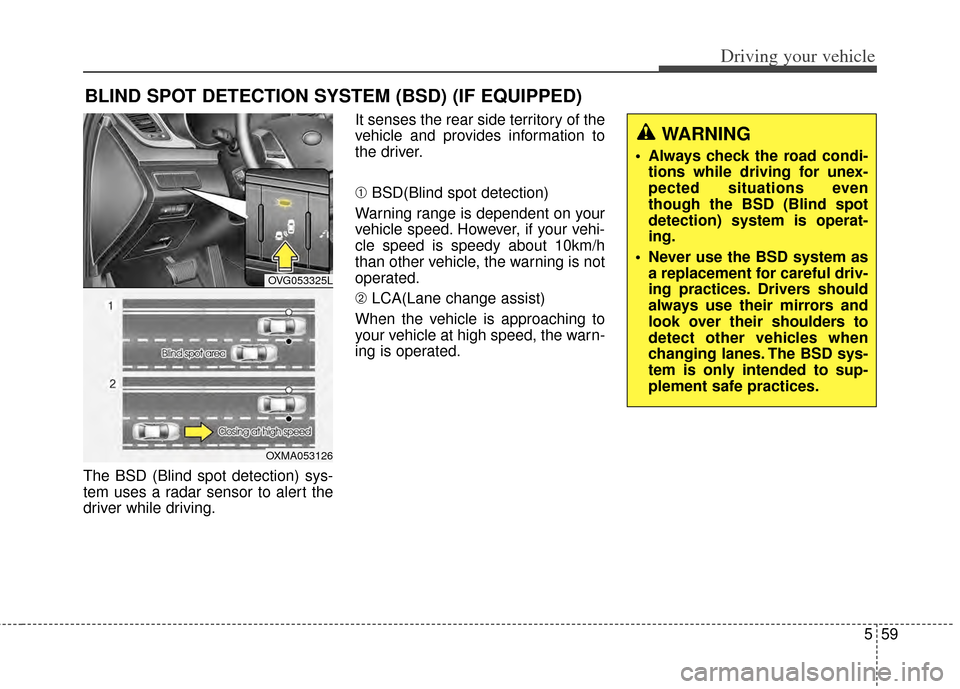
559
Driving your vehicle
The BSD (Blind spot detection) sys-
tem uses a radar sensor to alert the
driver while driving.It senses the rear side territory of the
vehicle and provides information to
the driver.
➀
BSD(Blind spot detection)
Warning range is dependent on your
vehicle speed. However, if your vehi-
cle speed is speedy about 10km/h
than other vehicle, the warning is not
operated.
➁ LCA(Lane change assist)
When the vehicle is approaching to
your vehicle at high speed, the warn-
ing is operated.
BLIND SPOT DETECTION SYSTEM (BSD) (IF EQUIPPED)
WARNING
Always check the road condi- tions while driving for unex-
pected situations even
though the BSD (Blind spot
detection) system is operat-
ing.
Never use the BSD system as a replacement for careful driv-
ing practices. Drivers should
always use their mirrors and
look over their shoulders to
detect other vehicles when
changing lanes. The BSD sys-
tem is only intended to sup-
plement safe practices.
OVG053325L
OXMA053126
Page 270 of 415
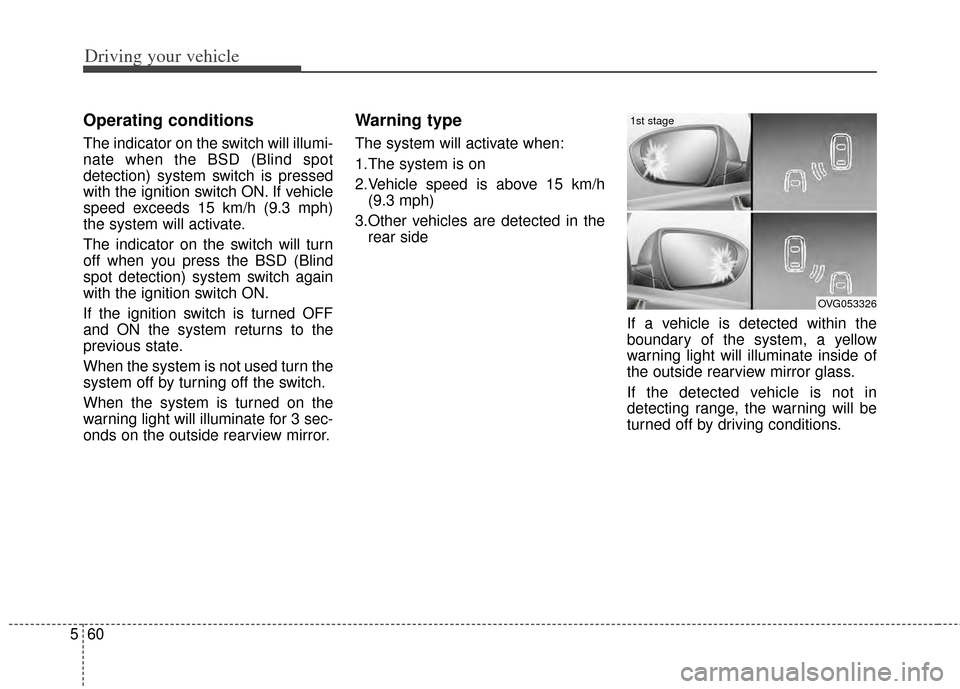
Driving your vehicle
60
5
Operating conditions
The indicator on the switch will illumi-
nate when the BSD (Blind spot
detection) system switch is pressed
with the ignition switch ON. If vehicle
speed exceeds 15 km/h (9.3 mph)
the system will activate.
The indicator on the switch will turn
off when you press the BSD (Blind
spot detection) system switch again
with the ignition switch ON.
If the ignition switch is turned OFF
and ON the system returns to the
previous state.
When the system is not used turn the
system off by turning off the switch.
When the system is turned on the
warning light will illuminate for 3 sec-
onds on the outside rearview mirror.
Warning type
The system will activate when:
1.The system is on
2.Vehicle speed is above 15 km/h
(9.3 mph)
3.Other vehicles are detected in the rear side
If a vehicle is detected within the
boundary of the system, a yellow
warning light will illuminate inside of
the outside rearview mirror glass.
If the detected vehicle is not in
detecting range, the warning will be
turned off by driving conditions.
OVG053326
1st stage